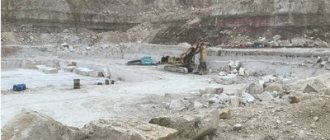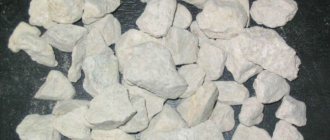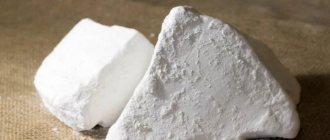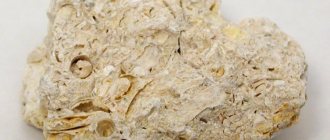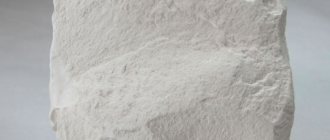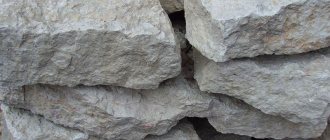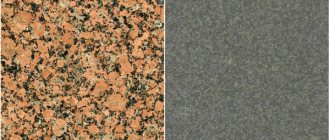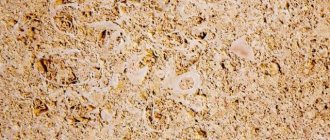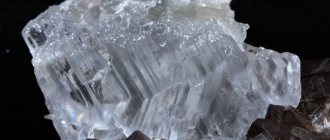Composition and properties of limestone
Limestone Rock
Limestone is a mineral formation comprising numerous varieties of calcium carbonate and is the most abundant in the earth's crust. In nature, their deposits are formed in the form of layers several hundred meters thick.
The rock is of sedimentary origin and has a layered structure. Chemically pure limestones contain 56% CaO and 44% CO2. Calcium carbonate, which is part of the mineral formation, slowly dissolves in water. Very often this property is the cause of the formation of karst voids underground.
The compound can decompose into the corresponding bases, releasing carbon dioxide. Under the influence of deep heat, carbonate compounds become a source of the gas component of mineral waters.
If the rock contains up to 17% magnesium oxide, then they form a group of dolomitized carbonate formations.
A mineral formation containing 25-50% clay components is called marl. Pure limestone is white. The presence of impurities of minor chemical elements in the mineral formation gives the rock a certain color.
The density of mineral formation is 2.7-2.9 t/m3, the compressive strength is 0.4-300 MPa. Limestone is used in many industries:
- in the chemical industry - for the production of soda, mineral fertilizers, calcium carbide, purification of petroleum products;
- sugar industry - for sugar purification;
- glass industry – for the production of thermally resistant glass;
- in construction - as materials for the production of cement, facing stone, and lime production;
- ferrous metallurgy - as a fluxing additive in the smelting of ore material.
The developed standards regulate the content of calcium oxide, as well as substances insoluble in hydrochloric acid, moisture and the mass fraction of pieces of sizes above or below the established permissible standards.
Main types of limestone
Due to the fact that limestone has a different structure, it is customary to classify it according to certain criteria:
- By origin;
- By chemical composition;
- By structure;
- By structure.
By origin
The following types of limestone are distinguished:
- Formed from residues of organic origin. Such limestones are also called organogenic. These include shell, reef and mud limestone;
- Formed when calcium precipitates. They are also called chemogenic;
- Formed after the destruction of older limestones. They are called clastic.
By chemical composition
- Marbled. This type of limestone is formed through a process of metamorphic changes in the material;
- Dolomitized. This limestone contains up to 17% magnesium. With an increase in this indicator, it degenerates into marl;
- Marl. Such limestone contains a quarter or half of clay particles.
In the video - marbled limestone:
According to structural characteristics
- Earthy. They are distinguished by their high fragility and friability, as well as insolubility in water;
- Marbled. They are characterized by a pronounced crystalline structure. These limestones include Jurassic;
- Dense. They are formed by particles of shells and shells of various marine animals, sometimes grains of lime spar;
- Separately, it is worth highlighting porous limestones (for example, aquifers, which are characterized by the presence of caverns and various cavities), tuffs, travertines and other materials of this type that contain foreign bodies.
By structure
- Pisolite. Its structure has grains reaching the size of a pea;
- Oolitic. They contain grains of a shell-like structure.
By color
Limestones are also divided by color. Natural is white, maximum light gray. Darkening of the structure, as well as the appearance of red, brown and other colors in it, is a sign of the presence of impurities.
By area of application
The following types of limestone are distinguished:
- Metallurgical or flux in the metallurgical industry is used as a flux in the smelting of metal and the manufacture of various alloys;
- Ground, which resembles flour. It is used mainly in construction for the production of dry mixes, asphalt concrete, etc.;
- Facing. It is used for cladding buildings;
- Sawn. Represents format blocks. It is used in the construction of houses.
Photos of some types of limestone
Fluxed limestone
Sawn limestone
Ground limestone
Facing limestone
Flux raw materials
Flux raw materials
Limestone is used in metallurgy to form low-melting slags. The flux is usually a material with opposite properties to the waste rocks found in the ores.
Silicate mineral compounds are relatively rarely used in smelting because most iron ores and almost all mineral fuels have a siliceous base.
Therefore, the use of carbonate compounds containing basic oxides as fluxing improves the process of ore purification during the extraction of the metal component.
Among them, the main place is occupied by limestone and dolomite. Limestones are used in blast furnace charge as pellets, sinter and in the form of pieces.
Depending on the purpose, the following types of carbonate material grades are distinguished:
- dolomitized – for converter and sinter blast furnace production;
- fluxing limestone – used for open-hearth, electric furnace, and ferroalloy production.
Fluxes in the form of powders are intended for the production without firing of periclase products and masses used for lining oxygen converters. The material has no expiration dates. It is loaded in bulk and transported by rail cars.
The metallurgical process of smelting 1 ton of cast iron or steel requires more than 50 kg of quicklime. It is used to produce the main slag that purifies iron ore.
The metallurgical industry requires materials to reduce heat loss during production. This allows you to reduce energy costs. The use of flux (flux) as an additive when extracting metals from ore lowers the melting point.
Theoretical foundations of metallurgical production
| 7.1 Metallurgical fluxes |
Fluxes are materials that are added to the charge to form slags in steelmaking units that have the necessary set of physical and technological properties. The following are most often used as fluxes in the main steel-smelting units: limestone, lime, bauxite, fluorspar, fireclay, etc.
Limestone is supplied in large quantities to the smelting charge during steel production in open-hearth furnaces using the scrap-ore process; it can also be used as a coolant for converter smelting.
Limestone is a natural form of existence of calcite (CaCO3). At high temperatures, calcite undergoes thermal dissociation according to the reaction
Reaction (7.1) occurs with the absorption of a large amount of heat. Therefore, to improve the heat balance of smelting, the use of lime is much more profitable. However, the production of lime in the quantities required for open-hearth shops operating with scrap ore, as well as storing it in dry form, is very difficult. Therefore, when a large consumption of calcium oxide is required for charging open-hearth furnaces, limestone is usually used.
When smelting steel in open-hearth furnaces, limestone is usually used as filler. In the initial period of smelting, the intensity of heat transfer from the torch to the bath is quite high, which makes it possible to compensate for the heat losses associated with the thermal dissociation of limestone within an acceptable time. Stirring the bath with carbon dioxide released during the dissociation of CaCO3 improves heat transfer from the torch to the bath. Oxygen CO2, used at approximately 50%, accelerates the oxidation of bath impurities, which reduces iron ore consumption. But all this does not allow us to fully compensate for the heat costs for the decomposition of limestone, so the use of high-quality lime for filling would provide a significant reduction in the duration of smelting.
When finishing the smelting, the intensity of heat transfer from the torch to the bath decreases, so lime is usually used to remove slag during this period of smelting.
Metallurgical enterprises in the South of Ukraine use limestone from the Elenovsky and Novotroitsky deposits, which contains: 51 - 54% CaO, 2 - 4% (SiO2 + Al2O3), no more than 0.04% sulfur and 0.01% phosphorus. Dolomitized limestone contains up to 14% MgO.
Lime is obtained by burning limestone, which is carried out in shaft kilns, rotary tube kilns, fluidized bed kilns, etc. When using sulfur coke as fuel for burning limestone, the sulfur content in lime can increase to 0.2 - 0.3%, which reduces its value as a desulfurizer. High quality lime is achieved by burning limestone using natural gas.
The metallurgical properties of lime are largely determined by the firing regime. “Soft fired” lime, which is quickly heated to a high temperature and quickly cooled, has high properties. Pieces of such lime contain a large number of cracks and pores, which contributes to a high rate of dissolution in the slag. If, during firing, lime is kept for a long time at high temperatures, recrystallization processes occur, as a result of which the metallurgical properties of lime deteriorate.
In air, lime actively interacts with atmospheric moisture, turning into calcium hydroxide. The supply of hydrated lime to metallurgical units is undesirable due to the additional heat consumption for the thermal dissociation of Ca(OH)2. In addition, such lime introduces a large amount of hydrogen into the bath of a steel-smelting unit, and fine calcium hydroxide powder is removed in large quantities from the working space of the unit. Therefore, it is recommended to store lime in closed bins. It is also desirable that no more than 24 hours pass from the end of lime burning to the time it is fed into the steelmaking unit.
When meeting these requirements is difficult, “nedopal” is used - a product of incomplete calcination of limestone, which contains 80 - 85% CaO, up to 4.0% SiO2 and 10 - 14% CO2. This material absorbs moisture more slowly than fully burnt lime.
When finishing smelting in open-hearth furnaces, lime can be used in pieces up to 150 mm in size. When smelting steel in converters, it is recommended to use lime in pieces 10–50 mm in size, which ensures fairly complete dissolution of it in the slag and reduces carryover during blowing.
Bauxite is used to accelerate slag formation and obtain the required slag viscosity when smelting steel in open-hearth furnaces. The main components of bauxite are Al2O3, Fe2O3 and SiO2. For example, bauxite grade B-6 for open-hearth production must contain no less than 37% Al2O3, no more than 0.2% S, no more than 0.6% P2O5, Al2O3/SiO2 >2.1.
The beneficial effect of bauxite on the properties of slag is due to the presence of alumina in it. A negative feature of bauxite is its high silica content, which increases the amount of slag and reduces the durability of the unit lining. Therefore, it is desirable to use bauxite with a silica content of no more than 10–12%.
Typically, to avoid significant losses during transportation, bauxite is moistened; its moisture content can be 10–20%. Therefore, bauxite must be dried before being fed into steelmaking units.
Fluorspar is a natural form of fluorite (CaF2). Typically, fluorspar contains 90 – 95% CaF2 and no more than 5% SiO2.
Fluorspar additives increase the rate of lime dissolution, promoting the formation of mobile, highly basic slag. However, the scarcity and high cost of fluorspar limits the possibility of its widespread use. For this reason, fluorspar is used mainly in steel smelting in electric arc furnaces. Much less frequently, in quantities up to 1–2% of the metal mass, it is used in the production of steel in oxygen converters using two-slag technology.
Fireclay waste containing 30 - 40% Al2O3, SiO2 and no more than 1% Fe2O3 can be used to reduce the viscosity of slag when smelting metal in electric arc furnaces. The advantage of fireclay compared to bauxite is the absence of moisture and iron oxides, which allows it to be used during the recovery period of smelting. The main disadvantage of this material is its high silica content.
| 7.1 Metallurgical fluxes |
Benefits of using limestone
Compared to other materials, limestone has the following advantages:
- The undoubted advantage of limestone is its high environmental friendliness;
- It lends itself perfectly to processing, which allows you to give it almost any shape and texture;
- Unlike, for example, brick or facing tiles, limestone retains its appearance for a very long time. Even if its surface is constantly exposed to adverse weather factors. That is why limestone is often used when cladding building plinths;
- Limestone has a porous structure, which allows it to perfectly absorb moisture from the environment. Therefore, the humidity in the room will be at the optimal level;
- High heat and sound insulation characteristics make the material ideal for exterior and interior decoration.
As you can see, limestone is an excellent material that can be used in many industries, mainly in the construction industry. Its excellent qualities allow us to say with confidence that this is the best material in its category.
Use of limestone in construction
Due to the large number of colors and textures, limestone is widely used in the construction industry. In the construction of buildings, limestone can be used as a base material (limestone bricks) or for cladding slabs.
In any case, the pieces of limestone are sawed. The main advantage of this material is that the size of its blocks can be varied. In addition, limestone has very high environmental characteristics, as it is a natural material.
Limestone is also used to design garden and summer cottage plots. It is used to form alpine slides and stone barbecues. Its advantage in this situation is its high durability, aesthetically pleasing appearance and ease of maintenance.
Limestone is also widely used in interior decoration. It is used to decorate balconies and stair railings. Due to its high ductility and easy workability, limestone can be used to make decorations and balusters of any complexity.
In some cases, furniture elements, kitchen and bar countertops, and even decorative elements, such as figurines and vases, are made from limestone.
The video will tell you how to work with limestone when creating sculptures:
Purpose of fluxes, requirements for limestone
| Random page | VOLUME-1 | VOLUME-2 | VOLUME-3 Architecture | Biology | Geography | Other | Foreign languages |
| Computer science | Story | Culture | Literature | Mathematics |
| Medicine | Mechanics | Education | Occupational Safety and Health | Pedagogy |
| Policy | Right | Programming | Psychology | Religion |
| Sociology | Sport | Construction | Physics | Philosophy |
| Finance | Chemistry | Ecology | Economy | Electronics |
Placer deposits | Metamorphism and ore formation | Ferrous metals | Manganese. | Classification of resources and reserves | Mineral exploration | Iron ore resources and reserves | Resources and reserves of manganese ores | Resources and reserves of chromite ores | Coal Resources and Reserves |
